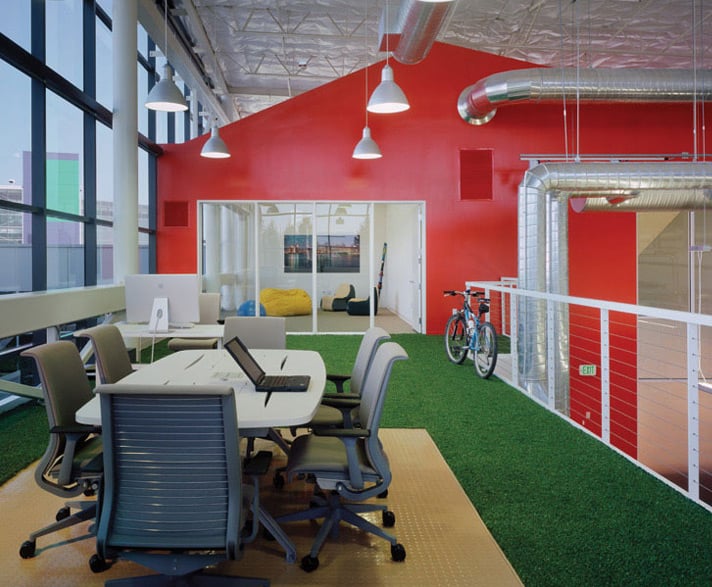How to Improve Collaboration in the Workplace

Kate manages Digital Marketing and ABM at VergeSense. She is interested in the ways we interact with the workplace, and how the purpose of the office continues to evolve.
Collaboration is an essential part of the modern workplace. It inspires creative ideas, supercharges productivity, and stimulates brainstorming sessions.
So, is your workplace suited for collaborative work?
Today, we will delve into the different types of collaboration you can expect in your workplace, the spaces that are proven to foster collaboration, and a glimpse into a success story of a company that accomplishes this successfully.
Formal vs. Informal Collaboration
To begin, there are two types of collaboration: formal and informal.
-
Formal collaboration refers to structured meetings such as team meetings or presentations.
-
Informal collaboration tends to look more like brainstorming sessions or impromptu conversations.
It is likely that your workplace features a mix of both, however sometimes the informal collaboration can be impeded if your workplace design isn't thought out with collaboration in mind.
The 4 Features of Collaborative Offices
Fostering collaboration starts with identifying spaces that best fit group work, brainstorm sessions and other interactive activities. You are unlikely to want to sit in a phone booth if you plan to have whiteboard brainstorm activity with your coworkers.
So, to get you started, here are 4 key features of offices that emphasize collaboration:
1. Open Plan Designs
This layout encourages collaboration between different departments, and on a more tactical scale, involves taking down walls in the office.
2. Quiet Areas
A common challenge with flexible spaces is the inability to find areas for focus time and individual work, because of the greater demand for collaboration. Quiet areas mitigate this challenge, through the allocation of phone booths and smaller huddle rooms.
3. Adaptable Workstations
These include standing desks, coffee bars, and outside of the office, a third place (like a coffee shop).
Check out how Miro creates adaptive spaces as part of their office design.
4. Unassigned Seating
Unassigned seating enables companies to adapt to changing employee demands and expectations, and provide more flexibility.
In an unassigned seating model, there isn’t a 1:1 ratio of employees and desks. The demand for desks and workstations aren’t based on headcount, but rather on a more holistic approach to understand the supply and demand of spaces.
Learn how to calculate your employee to seat ratio.
Striking the Right Balance of Spaces
When designing spaces to foster collaboration, it is important to create a mix of open and closed spaces. This gives teams a place to meet or hold conversations, but also provides some quiet areas for smaller groups or individuals to work in.
Movable furniture is also essential, as it allows teams to quickly change the layout of their space to suit their needs. Additionally, the office should be stocked with the necessary technology and resources to facilitate collaboration. Finally, color and lighting can be used to create a sense of energy and inspiration when collaborating.
How the Google Headquarter Promotes Collaboration Daily
Google's headquarters, also known as the Googleplex, features an open office layout with no assigned desks.

Image 1: Google Headquarters in Mountain View, CA. Source: Office Snapshots
Employees can choose to work from a variety of spaces, including open lounges, private phone booths, and even bean bag chairs. This design encourages collaboration and teamwork, as employees can easily gather in groups and work together.
The office also features spaces specifically designed for team meetings and presentations, further promoting collaboration.
Google's headquarters is filled with colorful, playful elements, such as slides and gaming rooms, creating a fun and relaxed atmosphere that fosters creativity and innovation. These additions to the company's workplace design not just aligns completely with Google's brand, but also fosters a positive work environment and company culture.
If you’re inspired and interested in learning more about what the best designed workplaces of today have in common, have a look at our latest resource → The 8 Best Designed Offices of 2022
Questions to Consider Before Implementing a New Workplace Design
When looking to foster collaboration in the workplace, it is critical to evaluate your current workspace and understand how it currently serves both formal and informal collaboration.
-
Do you have spaces dedicated to all types of collaboration as well as individual or small group work?
-
Have you allowed your team the flexibility to design their own workspace?
By incorporating open plan designs, quiet areas, adaptable workstations, unassigned seating, movable furniture, technology, resources, and the right color and lighting, you can create an office space that encourages collaboration.
To learn more about the best practices for designing workplaces, peruse our new blog post, "Workplace Design Best Practices".